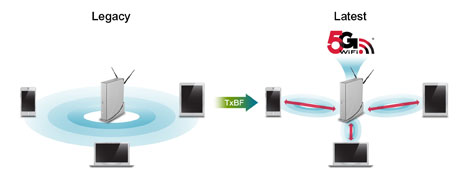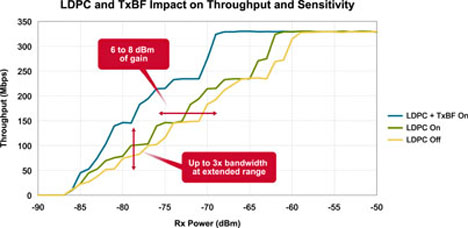BY CLINT BROWN
Director of BusinessDevelopment, Wireless Connectivity
Broadcom, www.broadcom.com
Wi-Fi-enabled devices are everywhere. By 2020, researchers estimate there will be 50 billion wirelessly connected devices worldwide. As a result, more consumers are demanding more speed, better reliability and greater power efficiency — in addition to multimedia-rich content and the ability to watch that content on everything from a computer, tablet, smartphone, television, and gaming console. Luckily, the 802.11ac standard, or the fifth generation of Wi-Fi (5G Wi-Fi), has emerged as the critical next step in allowing the wireless communications industry to meet these demands.
802.11ac promises to run faster and more efficiently than previous Wi-Fi variants, delivering Gigabit throughput, while operating in the 5-GHz band and having backward compatibility with other 802.11 technologies operating in the same band. It also promises to address one of the more pesky problems associated with Wi-Fi — its limited range and connection speed — using a combination of techniques like transmit beamforming and low-density parity check (LDPC) codes.
Consider a typical WLAN setup in a home environment with various devices (such as smartphone, tablet, laptop, printers, and TVs) connected via a wireless router. There may be multiple levels and walls in the home in this scenario, and not all spots within the home will have optimum connectivity. Most consumers have figured this out for themselves, often resorting to leaving a door open, for example, to improve the signal from the WLAN access point (AP) located in the home’s family room. Since continually moving the home’s AP is usually not an option, other means are required to improve connectivity.
802.11ac employs two optional techniques to boost connectivity performance by improving rate or throughput at a given range. The most effective and efficient of these techniques is beamforming, a nonproprietary technology that can be implemented across a wide range of devices and provides a two to three times improvement in wireless performance. Beamforming enables this by steering the RF energy in the direction of the intended receiver (see Fig. 1 ). It even allows wireless to be beamed around corners and through walls, which means that dead spots in the Wi-Fi network can be eliminated.

Fig. 1: With 802.11ac (and 802.11n) beamforming, the hub or AP focuses wireless directly at the device that needs it, regardless of how many devices are involved.
LDPC is a forward-error-correction coding scheme used to ensure high coding reliability and increase coding gain. Invented in the early 1960s, the code can transmit messages through frequencies experiencing a great deal of background or data-corrupting noise. Using it substantially reduces the chance of losing transmitted information on these noisy channels. The result is an incrementally better rate at range.
When used together, beamforming and LDPC can improve overall wireless coverage and capacity and increase the range over which 802.11ac’s 256 QAM is achievable. In fact, the increase may be as much as 6 to 8 dBm of gain and up to a 3X bandwidth improvement at extended range (see Fig. 2 ). On top of this, 802.11ac Wi-Fi supports 80-MHz channels, plus the optional use of contiguous 160-MHz channels or noncontiguous 80+80 MHz channels, which means there are essentially more lanes on the freeway to support increased traffic. In other words, 5G Wi-Fi can realize up to a fourfold bandwidth increase alone, just using 160-MHz over 80-MHz channels. Those are impressive performance improvements indeed, but what does it all mean for end users in real terms?

Fig. 2: LDPC and beamforming work together to significantly improve receiver throughput and sensitivity.
With no end in sight to consumer demand for more devices and more data, and with enterprise networks struggling to support a higher density of users while providing a better user experience, advanced techniques like beamforming and LDPC have now become all the more critical. By dramatically improving wireless connectivity performance, they are helping to pave the way for migration from legacy Wi-Fi standards to 5G Wi-Fi and ensuring the standard is ready to meet future connectivity demands as they arise.
To answer that question, picture a typical enterprise scenario characterized by an office space with multiple levels, populated by both hard offices and cubicles, as well as other spaces. One 802.11ac 3×3 WLAN AP and several 802.11ac stations are set up around the facility to provide employees with wireless connectivity. Throughput measurements with beamforming on or off are then taken at various distances from the AP. At 10 and 20 m, the throughput remains the same, with or without beamforming. By 30 and 40 m, it starts to become clear that beamforming increases throughput. The largest effect, however, comes at 50 m from the AP. Here, the use of beamforming increases throughput to 157 Mbits/s, as compared to the 87 Mbits/s achieved without beamforming — a whopping 80% increase. When LDPC is added to the mix, additional throughput increases can be realized.
Advertisement
Learn more about Broadcom





